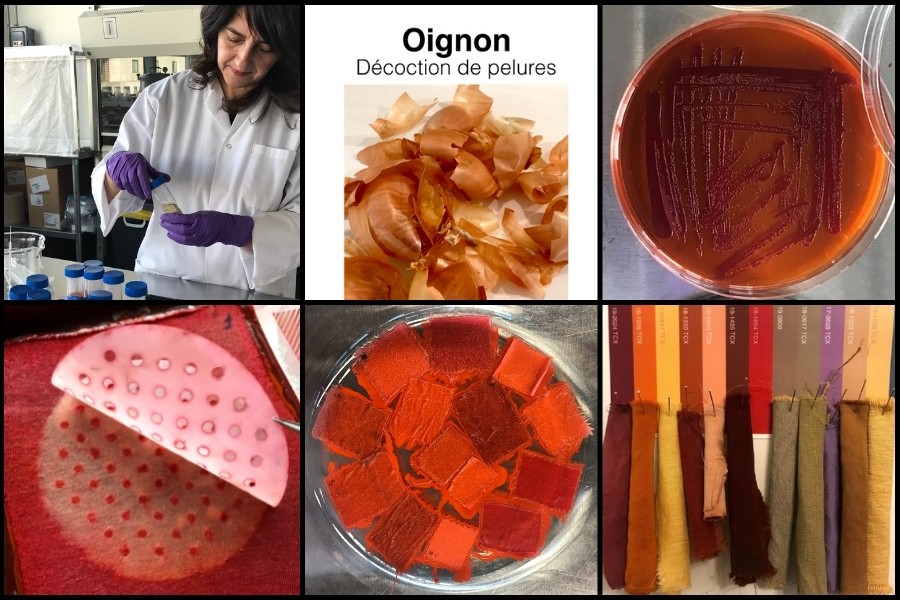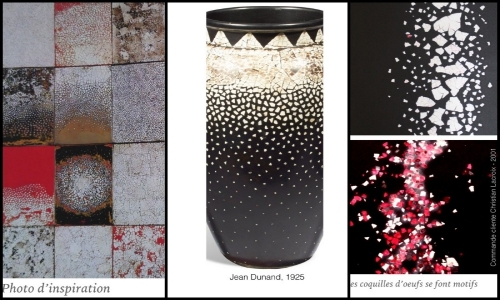Blog post
Research-creation with Vanessa Mardirossian: From the kitchen to the runway

This week we met with Vanessa Mardirossian - a fourth year PhD student at Concordia’s INDI Program - to talk about her career as a textile designer in the fashion industry, teaching and becoming a doctoral student. Vanessa expects to inspire future generations of designers to find ways to produce sustainable fashion through her PhD research. She is an experienced networker and a strong communicator. As a teacher and as a doctoral student she has made her research accessible to the public through media outlets.
What do food and fashion have in common?
Nothing, apparently, until you discover Vanessa’s research and textiles creations. Her inspiration stems from her love for food and cooking, so kitchen ingredients and food waste become raw material and inspiration for Vanessa’s textile designs. She created wonderful patterns and color to textile used on prestigious runway shows in Paris.
Why did you join the INDI PhD at Concordia?
Doing a PhD was not a straightforward decision. I wanted to reflect on my practice as a textile designer after working for twenty years across all the segments in the fashion industry. I have been concerned about the toxicity of the chemicals used to dye textiles through large scale production processes that damage people’s health and pollute our ecosystems. However, I was not sure how I could do this “reflection” on my practice. The PhD idea emerged when I met professor Ying Gao at the École Supérieure de Mode (UQAM) where I teach design. She advised me to pursue a doctoral degree to add to my experience in fashion and become a full-time professor. I took her advice and discovered the wonderful world of research-creation that combines art and science. The INDI program was perfect for me to have supervisors from design and chemistry that helped me advance my research.
How was your work with the international fashion houses?
I graduated from Master’s in Textile Design in 1998 at Central Saint Martin School of Arts in London (UK). After graduating, I started to work in the fashion industry in London. My work was well received and I was advised to contact big fashion houses in Paris. After showing my portfolio, I started to work in haute couture for fashion houses like Christian Lacroix, Givenchy, Kenzo, Chanel and Louis Vuitton. I loved the people I worked with because they were very open and approachable.
I worked with Christian Lacroix who would give me a photo with the trend he wanted to see on his next collection. My job was to create new patterns and colours that had the same feel of the photos Lacroix gave me. I was already using cooking ingredients like pasta, salt, feathers, couscous, dry flowers, and threads to create shapes and patterns. I did a textile design with eggshells that I got from a restaurant near my studio. I coloured the eggshells and started to play with the little cracked pieces of eggshell to produce a pattern.
 Vanessa's eggshell inspired creative process at Christian Lacroix: from inspiration to finished work
Vanessa's eggshell inspired creative process at Christian Lacroix: from inspiration to finished work
How did you get the idea to use food in your textile designs?
In 1996, I spent one month in Cuba and it was a very immersive experience. I learned how to use and reuse everyday material that I have at home to create shapes and patterns. The Cuban people living under the embargo do not have access to new textiles or material, so they are very creative to make new things with what they have at hand.
What is your PhD research about?
I research natural and non-toxic dyes produced by bacteria that feed on food waste. I use the research-creation methodology to merge art and science to make a sustainable process to colour textiles. In nature, there is no waste, so food waste becomes a resource.
I use vegetable and fruit leftovers, like orange or onion peels, from my kitchen to feed a particular bacteria that then produces colour patterns as they grow in a petri dish.
I take each type of food waste separately, soak it in water, and add bacteria. After 48 hours at room temperature, the bacteria will have on the specific food waste and produced a colour that I then use to dye textiles. For instance, avocado peels will make a pink colour. This natural colouring production can substitute non-renewable (petroleum) and toxic chemicals that are massively used in the fashion industry. As a teacher at the École Supérieure de Mode (UQAM), I aim at creating awareness of the problem of toxic materials used in fashion. I focus on introducing various innovative paths that students could take to make fashion design more sustainable.
How do you network and build collaborations?
As part of an academic research guided by practice, I think it is important to work in the field and collaborate with Montreal fashion and textile companies like Atelier B, Odeyalo or Montloup. My collaborations emerge from taking initiative to go and meet people to discuss common concerns about toxicity present in fashion's manufacturing processes. Our reflections lead us to mix our expertise and develop sustainable methods.
I am part of The Bactinctorium Collective, a networking that is exploring how bacteria can be used in colouring processes. I also take advantage of Concordia’s infrastructures to form collaborations like the Speculative Life Bio Lab Cluster and joined the Textile and Materiality Research Cluster, which are part of Milieux Institute. My colleagues and I found the collective Cyclical Matters to study bioplastic and biocomposite made of natural polymers from food waste. This project expanded into tutorials offering as part of the Hexagram project Sympoïètiques, under my director's supervision Dr Alice Jarry, who invited us to join an international collaborative project of giant bioplastic membran dyed with onion skins that culminated with an exhibition at the Centre Pompidou (Paris).
One year ago, I started using Instagram (@vanessamardirossian) to share my practice at the lab with the food waste and bacteria. I got noticed and received two invitations to talk on Radio Canada: Du côté de chez Catherine during the episode “Les enjeux environnementaux autour de la mode: Discussion”, and in Matthieu Dugal talk show Moteur de Recherche.
What was your biggest challenge in the PhD?
The first years of my PhD were challenging because they were focused on the theoretical aspects, so I was only reading and writing, without any lab practice. I had the feeling that I wasn't progressing because what I was learning wasn't tangible. However, when I started talking to people and explaining my research, I realized that I had learned a lot through reading. Now that I am doing the practical side of my research in the laboratory, I feel very inspired by all the theoretical side of my research.
For the preparation of my recent exhibition "Culture de la couleur", I started to work in the lab very intuitively. I experiment at a bigger scale, what I had tested and observed in my first tiny prototypes. I am freely experimenting and this has led me to exciting results that I shared through pictures and videos on my Instagram account.
What advice would you give to other students willing to showcase their work?
The best advice is to be proactive. Contact people in your field and provoke collaborations as they are great opportunities to transform your theory into practice. Working on joint projects will give you the opportunity to reflect. It will become an endless and virtuous circle of reflection, action, reflection, which will feed into the writing of your thesis.
Apply to exhibition calls, prize competitions and join research groups in your field of research. I recently met artists and researchers from around the world by presenting a paper at the 2021 ACFAS symposium. I am currently showing my research-creation project on Hexagram’s Demo online event. These research centres are great to make your work visible. I applied to the Colour Research Society of Canada (CRSC) competition, and I won the prize. I also recently received Concordia’s Sustainability Research Award to develop a series of workshops within the university and build an archive of sustainable design practices.
What are your future plans?
I find it really stimulating to conduct research in design, because it offers an ideal environment to develop a critical reflection on current practices. I enjoy participating in conferences where I can meet other researchers and viewpoints and foster new practices. I am considering a few options to continue exploring research-creation, like becoming a full-time professor, and acting as a consultant for companies specialised in textile dyes. I am taking advantage of programs like Mitacs and District 3 to facilitate connections with the industry after my PhD, so lots of possibilities. It is really quite exciting!
